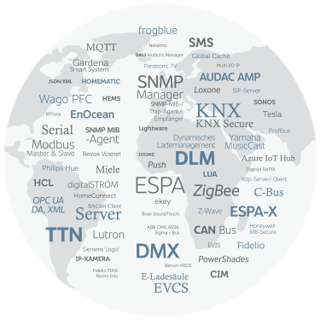 Frank Thompson: Here’s two big things right
now. Or three. Open, interoperable, and load shedding. Another one is
future-proof.
Frank Thompson: Here’s two big things right
now. Or three. Open, interoperable, and load shedding. Another one is
future-proof.|
December 2021 |
[an error occurred while processing this directive] |
| |
EMAIL INTERVIEW –
In this discussion with Rene Rieck, Frank Thompson, and Phil Juneau we discuss the differences in the European and American building automation markets, the difference between an automated and a smart building, and why the Ascend SCADA platform is such a valuable tool when it comes to connectivity.
Automated Technology Company
O: 417-625-6679 | www.atcjomo.com
| Articles |
| Interviews |
| Releases |
| New Products |
| Reviews |
| [an error occurred while processing this directive] |
| Editorial |
| Events |
| Sponsors |
| Site Search |
| Newsletters |
| [an error occurred while processing this directive] |
| Archives |
| Past Issues |
| Home |
| Editors |
| eDucation |
| [an error occurred while processing this directive] |
| Links |
| Software |
| [an error occurred while processing this directive] |
Question: Eisbaer is the basis for our
Ascend SCADA system. How long has Eisbaer existed and what does SCADA stand
for?
Rene Rieck: Sixteen years! SCADA stands for
supervisory control and data acquisition.
Question: What are the current challenges
in the building automation industry?
 Frank Thompson: Here’s two big things right
now. Or three. Open, interoperable, and load shedding. Another one is
future-proof.
Frank Thompson: Here’s two big things right
now. Or three. Open, interoperable, and load shedding. Another one is
future-proof.
Rene: Connectivity, future-proofness,
energy management, artificial intelligence.
Question: To give a comparison, what are
the current trends in the American versus European building automation markets?
Rene: The main goal over here in Europe in
building automation and bringing Eisbaer into play is the optimization of the
energy usage and the optimization of space. Everything should lead to carbon
and emission free buildings and raise the sustainability and well-being in
buildings; it’s all about the sustainability and well-being. That’s the
European approach at the moment.
Frank: In Europe they already have the
interoperability and the ability to monitor and shed loads on electrical
equipment and such. Here in the US we would be looking more at interoperability,
connectivity, and energy savings across the board. Making everything work
together.
 Rene: Connectivity is definitely one of the
big tasks.
Rene: Connectivity is definitely one of the
big tasks.
Question: Which would you say is further
ahead overall in terms of building automation technologies, Europe or the
United States?
Rene: We’re probably at the same point. The
only difference is probably that we have gotten to the point that we only have
a handful of systems in the building. We are having different types of building
automation technologies developed in our countries. We have American technology
coming this way, and you’ve got European technology coming your way. The
problem is that we have too many different technologies.
Phil Juneau: Also in Europe, you’re more
adoptive of standards and open protocols as opposed to the US. If you look at
the lighting industry, it’s predominantly proprietary protocols, whereas
everybody in Europe has adopted KNX.
Therefore, Europe has much more interoperability than the US. A good
example is that I was talking to a guy that runs the sustainability for all of
a certain company’s buildings across the US nationwide. He was saying, “Yeah,
we’ve got a lot of smart pieces in our buildings, but we have nothing talking
to each other.”
Question: Automated buildings are often
equated to smart buildings; is there really a difference between the two?
Rene: A fully automated building is not automatically a smart building, at least according to my interpretation. A fully automated building can be “dumb” as well. I can have automation where I have, say, a temperature sensor and you don’t have a static flow temperature; you can actually change the temperature. But that’s done by a temperature sensor in the wall. You go to the thermostat or system interface and you adjust it to whatever set point, say 72 degrees. That is automation because you can change the flow temperature when it’s appropriate, and the system will adapt automatically according to that room temperature. However, what it doesn’t take into account for instance, is how many people are in your room and what the weather conditions are outside. Do we have any wind? Do we have cloudy weather? Do we have the sun? Do we have the shades up? Do we have the shades down? What is the actual solar transmission via the windows? What does the window look like? Is it single glazed, is it double glazed, and so on and so on. A smart building would adapt to all these changing things which are actually out of the automated world but happening in the building all the time. If you had a meeting room with ten people in there then they radiate heat as well. That means if you have only two people sitting in a meeting room and you have a set temperature of 70, that might feel a little too cold. But if you have ten people, they’re radiating heat as well, so all of a sudden, the room is exposed to human heat. A smart system would say, “I have ten people in a room so I should put more energy into cooling.”
Question: Is there a next step from smart
buildings?
Rene: At the moment, we have all these
automated systems in our buildings. With all these room temperature sensors,
with motion detectors, with everything we’ve got in there we have tons and tons
and tons of sensor data, but nobody does anything with it. The step from an
automated building into a smart building is utilizing that data. On top of
that, when you then introduce artificial intelligence into the building, you take
the next step from smart buildings to cognitive buildings. Cognitive means it’s
changing depending on the usage, behavior of the clients, and so on.
Phil: The word that resonated with me that I had really never thought of was cognitive. To add to what you’ve said about automated versus smart buildings, I think the difference between a smart building and an intelligent building is the cognitive learning and the cognitive approach.
 Question: With all that information in
mind, how does the Ascend SCADA system come into play?
Question: With all that information in
mind, how does the Ascend SCADA system come into play?
Rene: We need a SCADA system, or a visualization system, to store, analyze, and make sense of the data because if there’s no context behind it, if that data isn’t being analyzed, then you can essentially just throw it in the bin. But when you have this data and a way to analyze it, you are able to optimize the building according to that data. That’s a smart building. Now if you introduce artificial intelligence into the building, you would be able to create a cognitive building which changes with weather conditions, how many people are in the building, which spaces are being used, and all these parameters. A big part of what our software does for the owner is optimize the building by improving the connectivity between the building’s devices.
Question: Why do you think many building
owners are apprehensive about updating their building management systems to
make their buildings intelligent?
Rene: A big concern is connectivity to legacy systems which are already in the building. It looks like they’re preventing people from making the step to intelligent buildings because of the fear that they will have to change the whole system in the building. So the legacy systems are one part of it, and of course having connectivity with the new systems in development. Here is what makes the Ascend platform so future-proof: On one hand, we have the legacy systems already in there, we do have the current IoT systems in there, and we are actually able to move into the new systems coming in the future. We’re able to add to the existing system, which makes our connectivity more versatile than anybody else’s. When you have the connectivity and are able to collect data, then you have the base set for making the building smart.

Question: The word connectivity has
been used many times in our discussion; what makes connectivity so important
for smart buildings?
Rene: Connectivity is the base of how the
building can talk to the software and the software is then able to get the data
stored, analyze the data, exchange it with AIs, and come back with control
values and hand that information over to the user. Connectivity is the big
thing. Connectivity would be easier if you had only one or two systems that are
standardized, but the building automation market is much more colorful than
that. This is why the Ascend SCADA system is such a valuable tool.

Frank Thompson
Automated Technology Company: Founder / Chief Operating Officer
Frank has been in the solution design business for 30 years and specializes in the following areas,
Intelligent Building, Intelligent City and Intelligent Factory Solutions, HVAC Controls, BMS and BEMS.
Frank is the VP of Technology KNX association US as well as subject matter expert in his field.
Frank optimizes logistics and field installation labor via pre-configured/programmed controls for HVAC equipment, Lighting, Security, Central Chiller Plants and overall Building Energy Management Systems.
Philip Juneau
Philip R. Juneau is a Business and Technology Consultant, Advisor for Automated Technology Company and Vice President of the KNX USA National Group. Phil has over 25 years of global experience in the building technology and automation market and continues to drive sustainable change to ensure our planet’s future prosperity.

Rene Rieck
Global Product and Innovation Manager at Alexander Maier GmbH.
Through his work as design and commissioning engineer, product development engineer and product marketing manager he looks back on over
26 year experience in the building automation business in Europe and abroad.
With the EisBaer software, his team and him solve the problems caused by the lack of connectivity and communication
between the growing number of intelligent devices of any building system technology and the IoT world in commercial, industrial and residential environments.
His vision is to help creating cognitive buildings that are able to autonomously learn system and user behaviour to optimize performance, efficiency and adapt to changing
conditions, which will lead to zero emission, carbon free buildings and a human centric, sustainable future
[an error occurred while processing this directive]
[an error occurred while processing this directive]
[Click Banner To Learn More]
[Home Page] [The Automator] [About] [Subscribe ] [Contact Us]